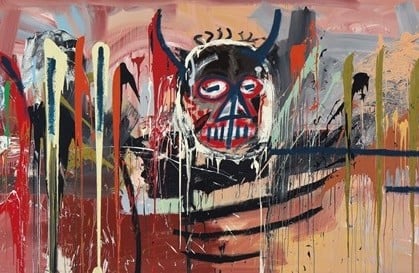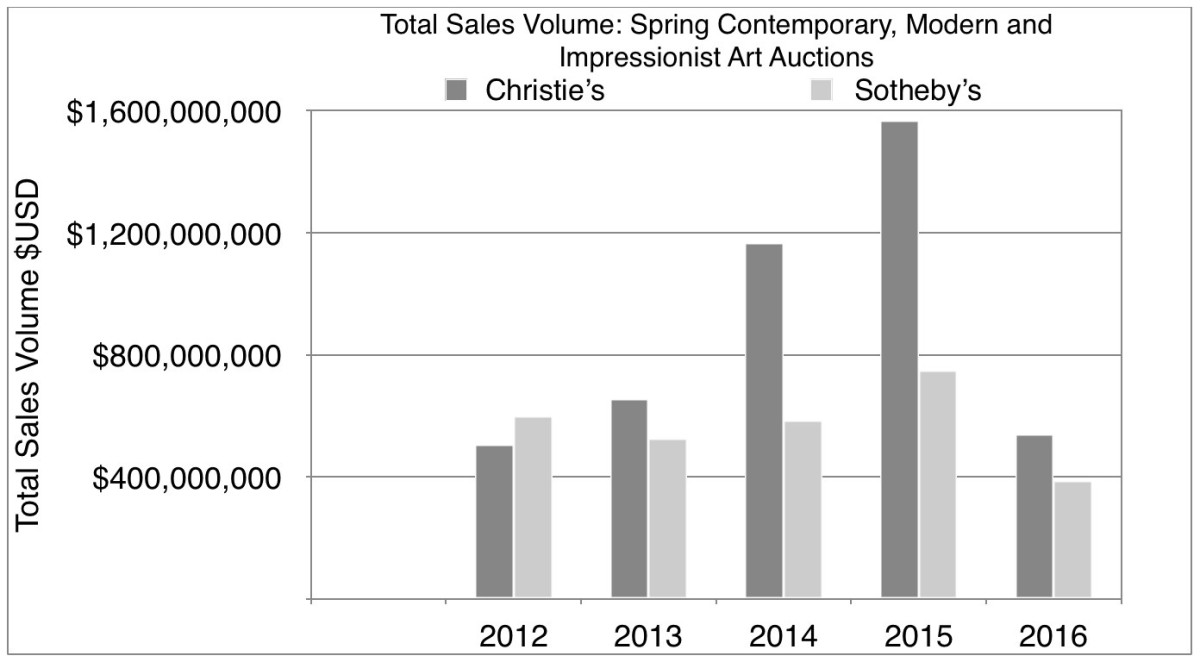
Image: Courtesy of Christie's Images Ltd.

Brian Boucher &
Eileen Kinsella

Additional reporting by Henri Neuendorf.
A Ho-Hum Return to Sobriety
Art market watchers approached last week, into which New York auctioneers Christie’s, Sotheby’s, and Phillips packed a punishing six sales over five nights, with trepidation. A slowdown in the art market at the top end, and a period of major upheaval at Sotheby’s, led to worries of a disastrous week.
That did not come to pass.
“The sky is not falling,” New York private dealer Andrea Crane told artnet News on Friday. “The sales were sober. People are buying. There’s no disaster out there, at all, and in fact the market is more solid than anyone thought it would be.”
“The market is certainly far from dead,” Christopher D’Amelio, senior partner at David Zwirner Gallery, told artnet News.
Related: Record-Breaking Basquiat Painting Leads Christie’s $318 Million Contemporary Sale
The results were reassuring especially in what has become the main sector of auction trading, the postwar and contemporary field. Impressionist and modern art auctions, however, were unimpressive at best, with Sotheby’s failing to sell one of three works on offer at that evening sale.
“One big takeaway is that contemporary seems to be clearly a much better barometer of the general art market, whereas Impressionist and modern used to carry the weight,” art advisor Todd Levin told artnet News. “That’s become more apparent than ever now, during this softening or retraction.”
Data from artnet’s Price Database illustrates that there has been a significant drop in sales volume in the spring evening auctions this year compared to last year.
Christie’s suffered an enormous drop, unable to repeat the remarkable $705 million “Looking Forward to the Past” curated sale which drove last year’s total. In contrast this year’s “Bound to Fail” curated sale only generated $78 million.
Meanwhile Sotheby’s total sales volume dropped almost by half. Last year the house generated $748 million in sales, compared to this year’s $386 million.

Sales volume is down relative to the last two years.
Graph via artnet Analytics
Experts say the sales indicated a return to sobriety on the part of the houses after overly ambitious estimates and excessive guarantees offered to sellers.
“We’ve gotten rid of the speculative market entirely, which is very healthy,” art advisor Lisa Schiff told artnet News. “People aren’t just grabbing up any great artist. They’re cherry picking the best. They’ll overpay for anything exceptional but they don’t want to pay at all for anything less. That’s the difference between a really frothy year and a year like this one.”
“I’ve been waiting for the market to normalize,” Levin said. “It was clearly skewed almost off the charts in terms of energy and money. Now that’s over.”
Related: Cy Twombly Canvas Leads Sotheby’s $242 Million Contemporary Art Sale
Everyone was watching Sotheby’s especially closely in the wake of staff departures and its controversial acquisition of advisory firm Art Agency, Partners. Experts were wary of attributing the results of the most recent sales to their presence, though the firm’s partners, Amy Cappellazzo and Allan Schwartzmann, may have proved helpful in coaxing sellers to agree to have more reasonable estimates assigned to their offerings.
“The discussion about realistic prices may have been easier because they have good relationships with the clients,” D’Amelio said.
To the experts, it was clear that both houses worked the phones with their sellers to agree to lower reserves (the minimum price at which sellers agree to let go of a work).
While volume at both houses was markedly down from past years, though, the auctioneers may have made better profits this time around as a result of fewer price guarantees. In past years, when the houses promised high prices to coax owners to sell, and then bidders didn’t materialize, the houses were left holding the bag.
“Both auction houses were trying to outdo each other with guarantees and valuations, and that couldn’t go on forever,” D’Amelio said, adding that even though volume was lower, the houses may actually have found the sales more profitable as a result.
Enthusiastic Buyers Meet Low-Confidence Sellers
The numbers tell a tale of lowered expectations. For example, Sotheby’s sale of postwar and contemporary art, which dealers and collectors called very strong, only squeaked by its low hammer estimate of $201 million to total $206.9 million without the house’s fees. The hammer total for Christie’s contemporary art sale actually fell short of the low estimate: $277.4 million on a low estimate of $285.6 million, even with a record-setting Basquiat.
But sobriety, and the absence of gigantic $100 million-plus trophy artworks seen in recent years, hardly means collectors aren’t shopping. The drop in sales volume, instead, reflects a downturn in seller confidence, as the houses had a tough time convincing collectors to consign top-level works.
“There is still a very enthusiastic and deep pool of buyers,” New York advisor Wendy Cromwell pointed out. As for the absence of mega-expensive works, she said, “Auctions are a very public forum in which to sell, and given the uncertainty in the presidential election year and the uncertainty in how hedge funds have performed, along with global economic and civil instability, it all just created an environment that’s not as optimistic for sellers.”
Japanese collector Yusaku Maezawa spent no less than $98 million over two days, harkening back to the 1980s, when Japanese buyers were all over the Western art market.
Related: Here’s What Japanese Billionaire Yusaku Maezawa Has Bought So Far at the Auctions
From D’Amelio’s perspective, though, the major market force from Asia continues to be China. “David and I are spending more and more time there,” he said, “as they learn more about Western art and we learn more about Chinese art.”
One question that remains for the auctioneers is what to do about the lagging sales of Impressionist and modern art. Dealers and advisors point out every year that it’s harder and harder to drum up appealing works in this sector. At Sotheby’s Impressionist and modern art sale last week, for example, one in three works failed to sell, a percentage that Levin termed “catastrophic.”
Both D’Amelio and Crane saw Christie’s “curated” sales, fronted by deputy head of postwar and contemporary art Loic Gouzer and mixing works from a range of historical periods, as the way forward. “These combined sales, with the sensibility from a younger person like Loic, are vastly important for Impressionist and modern field to be strong,” D’Amelio said.
“I think Loic’s ideas are brilliant, I really do,” Crane said, “and while it’s exhausting to add a sale during the week, I have really enjoyed his vision. I think it’s effective.”
If anything, Crane added, considering the weak Impressionist and modern results, it may be time for an even more major shakeup, with, for example, 19th-century works consigned to a different sale, and works from the modern and contemporary periods combined in a new department. The houses could then consider contemporary-only sales.
“You have to spruce things up somehow,” she said.